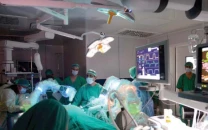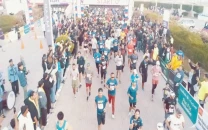Heritage beyond buildings
Experts stress on conceptual understanding of heritage, point out systemic flaws

An old building in Saddar Town is in dilapidated condition, leaving it susceptible to accident. PHOTO: PPI
Speaking at a session titled 'The Future of Karachi's Heritage' at The Karachi Conference 2019, Hasan personified the building as a woman. He called for a conceptual understanding of the word 'heritage' which goes beyond the building with a life of its own. "There are signs of history in every corner of our country. And you cannot look after all of them. The need of the time is that they should be saved from destruction. Sure, restore the ones you can, but protect them all [from deteriorating]."
Fire engulfs World Heritage castle in Japan's Okinawa
The list that the Supreme Court sought, as panellist Danish Zuby of Shehri-Citizens for a better environment, pointed out, has been in the works since 1984. According to Zuby, by 1986, architect Yasmeen Lari had identified around 600 significant buildings in Karachi. "These ancient buildings of our city are like orphaned children. Although we've listed them out, we haven't developed a proper mechanism for what's to happen next. There is no institutional backing, no legal coverage [for the future of these sites]."
The speakers stressed that while laws exist to preserve Sindh's heritage sites - Sindh Cultural Heritage (Preservation) Act 1994 - there is little to no work being done on the actual enactment of the law.
Zuby laid out the process in four stages with listing being only the first stage towards the preservation of heritage sites. The second stage, according to him, is an investigation of ownership and in certain cases, the people occupying or residing in the said building. This would then be followed by gauging the structural strength of the site and the initiation of remedial programmes in the fourth stage.
A problem, however, with these stages coming into practice, as panellist Dr Anila Naeem of NED University pointed out, is that there is little to no training imparted to government officials in terms of heritage preservation. The same flaw persists in our education system as well, she added.
Rs251m allocated for revival of Multan’s heritage
The speakers were expanding upon the issues highlighted by archaeologist Dr Kaleemullah Lashari who gave examples of restoration efforts at Frere Hall, Edward House, and the Police Museum of Karachi, among others, as sites where restoration work reached a certain stage but was then met with red tape, which caused hindrances in some works and brought others to a halt. Chief among his examples was the case of Mithi Ram Hostel where restoration work was prevented from completion.
Lashari recounted, that there were proposed restoration works after the blast in 2009. "However, there were vested interests in not restoring the building. The owners wanted expansion work which was also beneficial for traders and they supported the demolition of the site instead," he said while maintaining that the funds had been arranged for restoration by people engaged in the restoration work. According to Lashari, the vested interests connived with officials and the police to prevent the restoration of the building. The site is now occupied by Rangers who use the building as a sub-jail. "The plan [for restoration] which is proposed is done with the sanction of the government and the funds are provided by the government. However, before reaching completion, the work is halted, and the government takes no notice of the matter."
"We've made the Acts [the laws], but the rules haven't been made," said Lashari referring to the heritage preservation act. He emphasised that this systemic flaw has led to poor implementation of the existing laws at the expense of sites marked for preservation.
Meanwhile, a paper written by James Strachan, entitled, 'The Karachi Waterworks' was presented by Dr Abdul Rehman, which brought home Hasan's point of heritage extending beyond buildings. Rehman walked the audience through the 150-year old water system, established by Strachan, of which one well still remains functional and supplies 500,000 gallons of water to Gadap Town on a daily basis. The network of wells exists to this day, and while they aren't all functional, they are still significant fixtures in the lives and memories of those who live in the area. Karachi Metropolitan Corporation Land Archives Project Director Fareed Ahmed also presented a paper explaining KMC's efforts towards documentation of written heritage which included the print editions of local newspapers. The audience appreciated the KMC's efforts and also knowingly laughed when Hasan asked Ahmed as to where these archives were stored.
Published in The Express Tribune, November 3rd, 2019.



















COMMENTS
Comments are moderated and generally will be posted if they are on-topic and not abusive.
For more information, please see our Comments FAQ